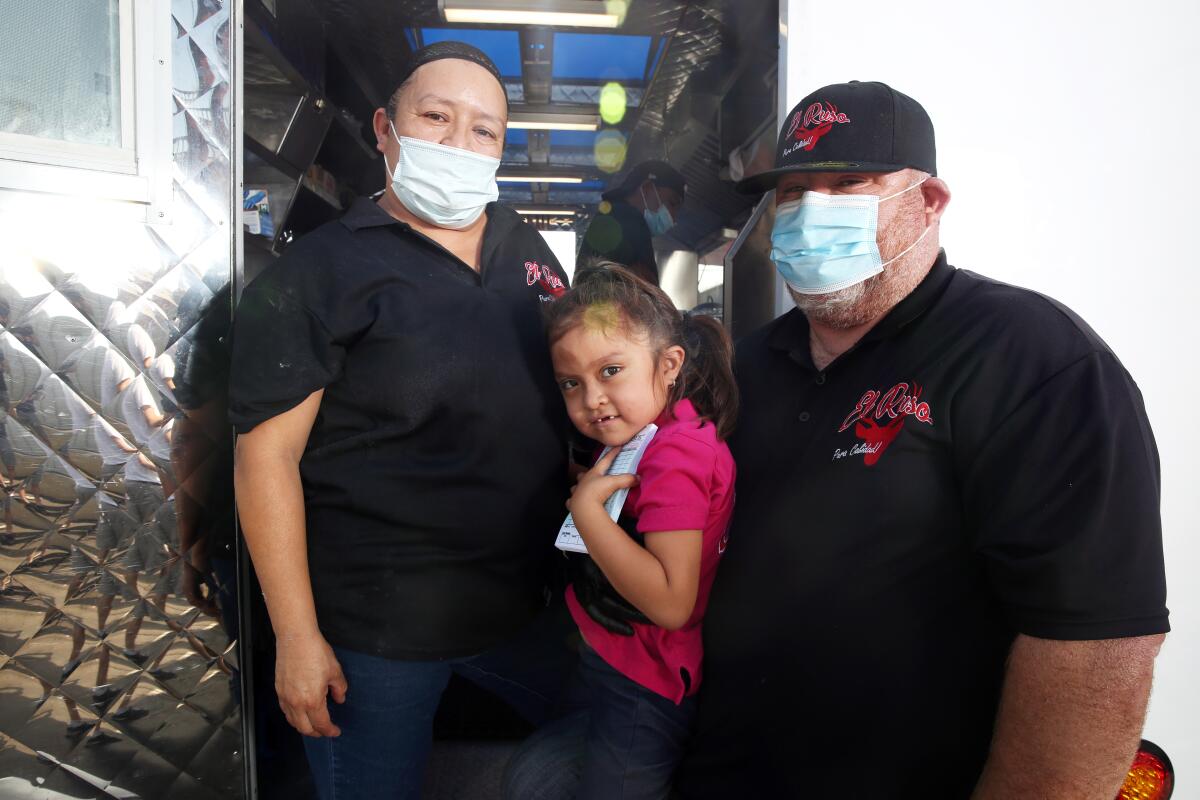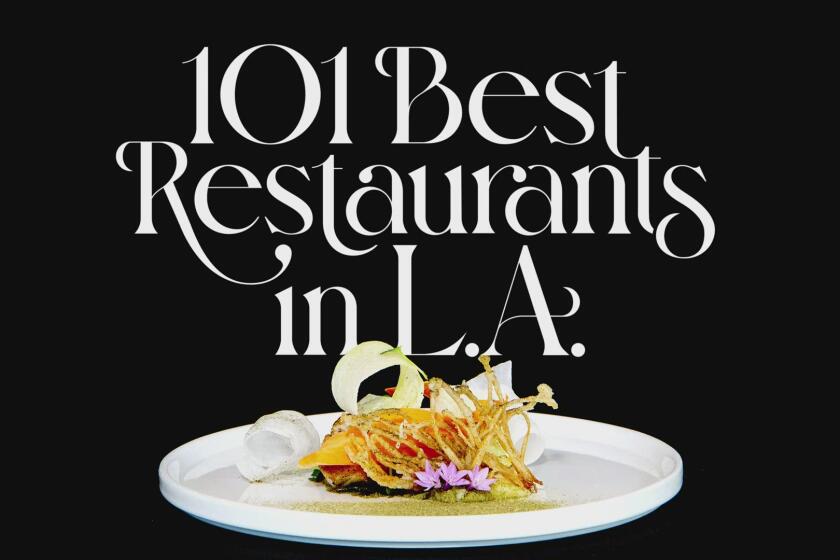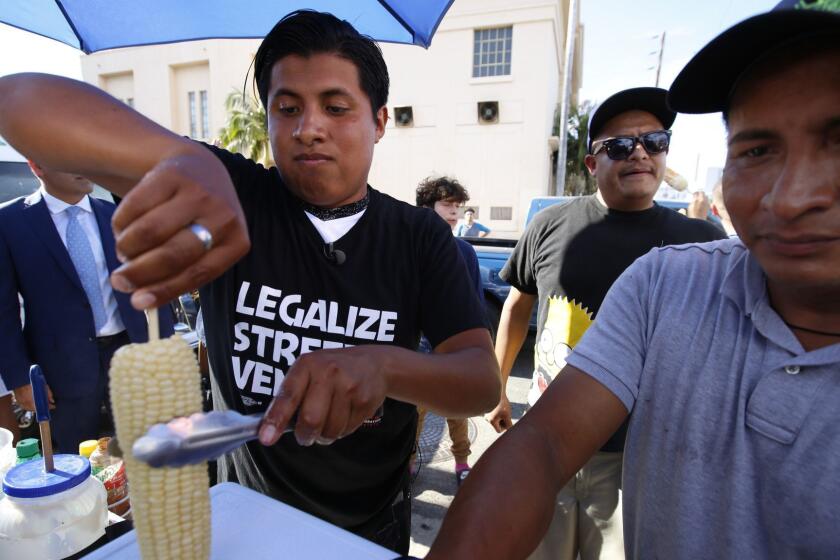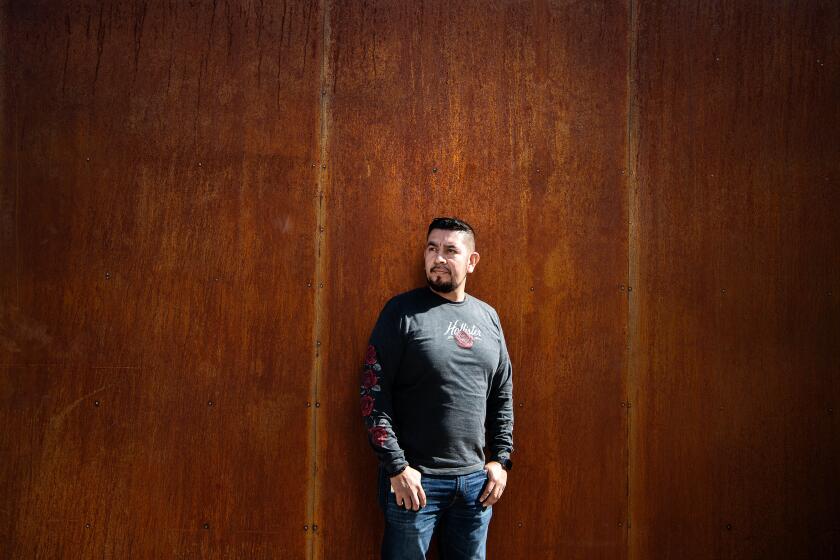Column: He’s L.A. food royalty. He began with a taco cart. Let street vendors thrive

- Share via
When I first met Walter Soto in 2019, the Mexican immigrant would park his El Ruso taco cart in an industrial section of Boyle Heights, where the customers were as likely to be unhoused people as they would be foodies.
His quasi-restaurant was tiny — about as big as the walk-in cooler at a restaurant — and there were days where Soto, a jovial, red-headed giant who looks more like an SEC football coach than a chef, wondered why he had left his job as a construction foreman.
But through hustle and heart, Soto became food royalty in Los Angeles. He quickly graduated to a bigger trailer in a nicer part of Boyle Heights. His Sonora-style tacos — think fatty carne asada, luscious chicharrones, furious salsas, everything tucked into flaky flour tortillas as small as the palm of your hand or larger than a basketball hoop — earned praise in local, national and international publications and television shows.
Last year, he even nabbed a spot in the most recent edition of the L.A. Times 101 List, our annual compendium of the best restaurants in Southern California.
Now, El Ruso (“The Russian”) consists of three taco trailers across Los Angeles. The mother ship is the one the size of a Minnie Winnie that sits on a parking lot off Sunset Boulevard in Silver Lake complete with bench seating, potted plants and a small office-cum-kitchen. The latter’s layout is modest — framed posters that haven’t yet been hung, a restroom and a massive desk upon which stands a tabletop money tree. But for Soto, it’s his American dream.
If you’re searching for the essential food of L.A., let our critic’s 2021 restaurant list be your guide! Find the best vegetarian, Japanese, Mexican cuisine and more.
“Here, I can write checks,” said the 43-year-old, as he saw workers pat out flour tortillas with their hands. He then gestured to his 6-year-old daughter, Suri, who sat in his office chair while she watched Barbie YouTube videos. “When it rains, my daughter can be inside a warm room instead of underneath a tent. To be here on Sunset, well, it’s an honor. I feel super-chingón [badass].”
I can’t think of a better recent example than Soto of someone who rose from the streets to find success. That’s why I wanted to check in with him early in this new year, in light of a December that saw California bureaucrats launch the latest campaign against one of their oldest enemies: street food.
In East Los Angeles, county workers painted the curb on a stretch of Whittier Boulevard red for a couple of weeks to keep off the taco trucks that had parked there for years. In Anaheim, city officials have teamed up with the Orange County Health Care Agency to crack down on the taqueros, tamaleros, fruteros, and hotdogueros that have enlivened my hometown’s food scene in recent years.
In San Francisco, that paragon of woke wackiness, police officers ticketed unlicensed food vendors in Union Square. Television stations captured public workers hauling off coolers of tamales in city trucks as if they were handling hazardous waste.
For more than 140 years, officials in the Golden State have repeatedly clamped down on street vendors via laws, raids and campaigns demonizing them as a public nuisance, only to have vendors come back stronger than ever. It’s like that classic Mad magazine cartoon, “Spy vs. Spy,” with the only victims being the entrepreneurs who have the bad luck of getting caught.
And it doesn’t matter if you have all the necessary permits, like Soto always has.
“Even though I have them, [code enforcement] can come to mess with you,” he told me. “Sometimes, their job is not done to better society, but just to ruin people’s livelihoods.”
He remembered the time that code enforcement confiscated the stall of a Latina with two small daughters who sold fruit down the street from his original El Ruso location. “They threw perfectly good mangos into the trash in front of people,” Soto said with disgust. “Why mess with her? It’s unconscionable to do that. Have some heart.”
So for 2022, I urge city and county governments across California to let street vendors operate with no hassle once and for all. Forget about legalizing them — just let them do their thing, and let customers decide whether they survive or naturally shut down.
Whenever someone tells me that street vendors are a civic nuisance — hawking unsanitary meals, neglecting to pay taxes and stealing customers from legitimate brick-and-mortar restaurants — I respond by sharing memories of the three times I suffered food poisoning in disgusting, vivid detail.
I’ve never bought any of the arguments opponents throw against street food. Hygiene? As a former food critic who easily ate at more than 1,000 restaurants during his career, I got food poisoning only from high-end spots. Unfair competition to brick-and-mortar spots? As someone whose wife owns a restaurant, I know success goes more to those who step up against competition instead of whiners. Unlicensed vendors don’t pay taxes? Neither do many multibillion-dollar businesses — but I didn’t see authorities barge into Amazon warehouses and toss inventory into Dumpsters when the company didn’t pay federal taxes in 2017 and 2018.
Besides, street-food slingers like Soto are the state’s ultimate rags-to-riches story. Some of the most iconic food personalities in Southern California history — Carl Karcher of Carl’s Jr., Roy Choi of Kogi Korean BBQ, the King Taco and Guelaguetza empires — started with carts or trucks that polite society frowned upon. No other narrative combines our love of food, capitalism, urbanism, convenience and innovation better.
Politicians will claim it’s easier than ever for people to sell street food.
In 2018, then-Gov. Jerry Brown signed the Safe Sidewalk Vending Act, which was supposed to decriminalize street food, discourage municipalities from targeting vendors, and make it easier for them to come out of the proverbial shadows. Soto welcomed that development, and thinks his fellow vendors should operate within the law.
Economic, lightweight vending equipment that meets health codes is practically impossible to find. Revolution Carts is hoping to change that.
“I’m in a country that’s not mine,” he said. “So we have to understand that sometimes, we can offend if we don’t leave a place clean or set up somewhere without the permission of the businesses around it.”
He then repeated a saying attributed to former Mexican President Benito Juárez: El respeto al derecho ajeno es la paz. Respect for the rights of others is peace.
But Soto then pointed out it’s almost impossible for immigrants like him to get on the right side of the law due to costs.
The first little trailer I remember him in cost $35,000, and he bought a pickup truck for $15,000 in order to tow it. Right now, the going rate for a new taco truck is $130,000. The only legal tamale cart allowed by L.A. County right now costs $7,500 — a preposterous amount few will pay up for when they can make tamales at home, put them in a pot and sell them out of their car trunk.
And then comes the many, many permits and fees municipalities require.
“If people sell without a permit, it’s not like they’re doing it to purposefully break the law,” Soto said. “Everyone has their reasons.”
I stepped out of Soto’s office to place my order for some chorizo tacos and a dozen flour tortillas to go. Before the door shut, Soto offered a final thought.
“Don Arellano, I needed a lot of strength to do this,” he said. “Anyone who does this needs strength as well. They just want to make a living. To those who want to criticize street vendors, have some heart.”
More to Read
Sign up for Essential California
The most important California stories and recommendations in your inbox every morning.
You may occasionally receive promotional content from the Los Angeles Times.















